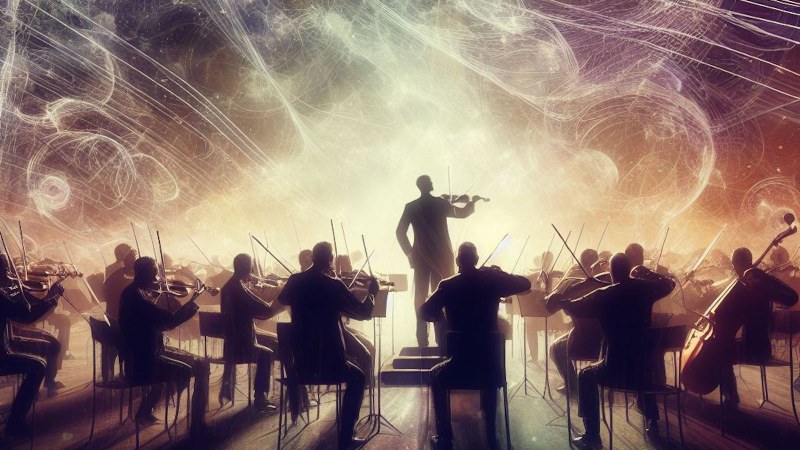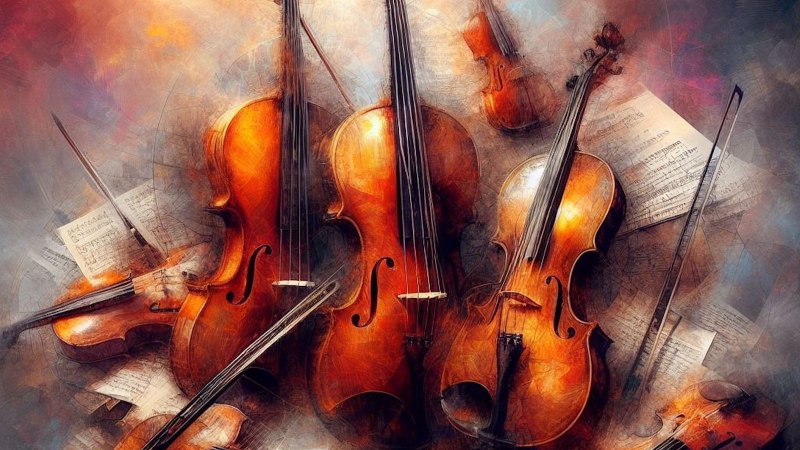Imagine an orchestra without its soul, a symphony without its heartbeat. That's an orchestra without its string section.

The Heartstrings of the Orchestra: A Journey through the Ages
In the vast tapestry of musical history, few sections of the orchestra have garnered as much admiration and intrigue as the string section.
This assembly of instruments, characterized by their resonant tones and emotive capabilities, has not only shaped the evolution of orchestral music but has also deeply influenced cultures and traditions around the world.
Historical Resonance
The roots of stringed instruments reach deep into ancient history, from the Mesopotamian lyres to Egyptian harps. As these instruments developed and journeyed across lands, they became integral to royal entertainment, sacred rituals, and cultural folk practices.
By the time the Renaissance period dawned in Europe, stringed instruments like the viol had become mainstays of musical ensembles, paving the way for the development of the modern violin family we recognize today.
Cultural Significance
Across diverse cultures, the string section has always been more than just a musical entity.
In China, the guzheng, a plucked string instrument, has been a symbol of elegance and refinement.
Similarly, in the Indian subcontinent, the sitar and sarod have not only entertained but also spiritually elevated listeners through ragas.
As these instruments intertwined with cultural narratives, they became emblematic of a region's history, ethos, and artistic expression.
Invaluable Contribution to Music
The true value of the string section lies in its unparalleled versatility.
From the soul-stirring adagios of classical symphonies to the vibrant rhythms of folk dances, string instruments have showcased an ability to adapt and resonate with diverse musical genres.
Their rich tonal qualities, combined with their capacity for both lyrical subtlety and powerful projection, make them indispensable in conveying the myriad emotions that music seeks to express.
The Orchestra's Resonating Heart: Dive into the String Section
The orchestra, a harmonious blend of various instruments, has always been a symbol of musical grandeur.
Among its sections, the string family stands as both the orchestra's heart and soul.
Their sound, often described as the closest to the human voice, brings unparalleled depth, emotion, and nuance to compositions.
This section's instruments, ranging from the high-pitched violin to the deep tones of the double bass, work in tandem to provide the orchestra its tonal foundation.
The Essence of String Instruments
Upon laying eyes on a string instrument, its wooden structure is prominently visible, leading many to question why they are termed 'string' instruments.
These instruments have hollow wooden bodies, each meticulously crafted to resonate and amplify the vibrations from the strings.
These strings, often made of materials like nylon, steel, or gut, produce sound when played with a bow, which interestingly has strings made of horsehair.
Occasionally, musicians might pluck the strings with their fingers, lending a different texture to the sound.
1. Violin: The Melodic Leader
The violin, the smallest member of the string family, often takes the spotlight in orchestral pieces. Its high-pitched, bright tones can stir profound emotions, making it integral in leading melodies.
Typically, an orchestra can house up to 30 violins, further divided into first and second groups.
The first violins frequently play the melody, while the second violins oscillate between melody and harmony.
2. Viola: The Rich Middle Ground
A close relative of the violin, the viola stands slightly larger and is known for its deeper, richer timbre.
The viola plays a crucial role in adding harmonic depth, often filling in the middle grounds of musical compositions.
3. Cello: The Soulful Anchor
The cello, with its deep and sonorous tones, adds both gravitas and warmth to orchestral pieces.
This instrument is versatile, lending itself to both soul-stirring melodies and rich harmonies.
Played sitting down, the cello's sound is a bridge between the viola and the double bass.
4. Double Bass: The Resonating Foundation
As the largest member of the string family, the double bass offers a foundational support to the orchestra with its deep, resonant sounds.
It plays a pivotal role in maintaining the rhythm and harmonic base, anchoring the entire ensemble.
5. Harp: Ethereal Resonance
The harp, often seen as an outlier in the string section, brings an ethereal touch to any orchestral composition.
With its strings plucked to produce sound, the harp can evoke a sense of dreamy beauty, adding a unique layer to the musical tapestry.
The String Family: A Closer Look
The string section, often hailed as the heartbeat of an orchestra, comprises instruments that resonate with unmatched depth and warmth.
These instruments, characterized by their vibrating strings, not only form the largest group in the orchestra but also contribute significantly to its tonal richness.
Their wooden construction and the varying tension of their strings give each instrument its distinct sound.
1. The Quartet of Resonance
The primary members of the string family include the violin, viola, cello, and the contrabass or double bass.
These four instruments, differing in sizes and tonal ranges, together lay the foundation for the string section's rich sonic tapestry.
2. The Harmonious Harp
While the harp is indeed a part of the string family, its nature and playing technique set it apart from its counterparts.
Given its unique attributes, we will delve deeper into the harp's characteristics separately.
3. Craftsmanship and Sound Resonance
String instruments are meticulously crafted with wooden bodies that are hollow inside.
This design allows the sound produced by the strings to be amplified, resulting in the instrument's characteristic resonance.
Whether played with a bow made of wood and horsehair or plucked with fingers, these instruments produce sounds that are both profound and captivating.
4. Versatility and Depth
The string family stands out due to its unparalleled versatility.
Capable of playing sweeping romantic themes, intense horror cues, or powerful heroic melodies, these instruments can seamlessly blend with any orchestral setting.
String Instrument Ranges and Characteristics
1. Playing Ranges
Understanding the playing ranges of string instruments is crucial for composers.
The string section typically comprises first and second violins, violas, cellos, and contrabasses.
Each instrument has its unique tonal range, with the double bass producing the lowest tones and the violin the highest.
2. Unique Traits
- Unfretted Freedom: Unlike guitars or pianos, string instruments don't have frets or pre-defined keys. This unfretted nature allows musicians to play any note within their range, making them perfect for atonal compositions.
- Continuous Play: Unlike wind instruments, string instruments don't require pauses for breath, allowing for longer melodic lines.
- Speed and Flexibility: String instruments can execute rapid melodic scales, runs, and arpeggios, providing agility to compositions.
- Multitonal Capabilities: Instruments like the violin or cello can play multiple notes simultaneously through techniques like double or triple stops.
- Tonal Variations: The tone of a string instrument varies based on its range. Lower registers offer a warm sound, while higher ones produce brighter tones.
- Articulation Diversity: From legato to staccato, strings can adapt to a plethora of articulations, enhancing their expressiveness.
3. Blend and Harmony
Strings have the innate ability to blend seamlessly with other orchestral instruments.
By doubling melodies or harmonies with strings, composers can amplify and enrich their compositions.
The string section, with its unparalleled depth, versatility, and resonance, remains an indispensable part of any orchestra.
Their ability to adapt, express, and resonate makes them the go-to choice for composers across the globe.

Exploring the World of String VSTs: A Digital Symphony
In an era where digital tools have revolutionized music creation, Virtual Studio Technology (VST) plugins stand tall, offering a bridge between the tangible beauty of acoustic instruments and the limitless potential of the digital realm.
For those seeking to emulate the rich, enveloping sound of string instruments, various VSTs have emerged as frontrunners, seamlessly merging authenticity with versatility.
1. Orchestral Tools Berlin Strings: The Gold Standard of Virtual Strings
Regarded as one of the industry benchmarks in the world of orchestral strings, Orchestral Tools Berlin Strings promises a library that leaves listeners spellbound.
- Captivating Authenticity: This VST boasts a collection of string instruments that reproduce MIDI mockups with a fidelity rivalling live recordings. The meticulous recordings at the renowned Teldex Scoring Stage in Berlin, a venue graced by globally celebrated orchestras and pop icons alike, attest to its quality.
- Unprecedented Realism: The standout feature is undoubtedly its "First True Adaptive Legato", capturing every interval up to an octave, ensuring a seamless legato transition between any two notes. This adaptive approach automatically selects the most appropriate legato style, delivering an organic flow to compositions.
2. Orchestral Tools Berlin Symphonic Strings: A Cinematic Delight
A newer entrant from Orchestral Tools, the Berlin Symphonic Strings places a spotlight on vast string sections, embodying the spirit of cinematic grandeur.
- Ensemble Depth: With instrumentation echoing the expansive setups of major film industry orchestras, this VST offers both scale and nuance.
- In-Situ Recording: Recorded at the Teldex Scoring Stage, the samples benefit from traditional strings seating arrangements, ensuring a cohesive sonic blend. Furthermore, its extensive microphone positions allow for precise soundscaping, offering a multitude of sonic perspectives.
3. EastWest Hollywood Strings (Diamond Edition): The Sound of the Silver Screen
The collaborative effort of cinematic maestro Thomas Bergersen and ace engineer Sean Murphy, EastWest’s Hollywood Strings is an ode to the glamour and gravitas of Hollywood's musical legacy.
- Crafted with Detail: This extensive library offers granular control over string nuances, from finger placements and dynamics to varied articulations.
- Historic Echoes: Recorded at the legendary EastWest Studio One in Los Angeles, the library channels the sonic essence of iconic artists, from Frank Sinatra to the Rolling Stones.
4. Audiobro LA Scoring Strings (Full 2.5): A Symphony of Flexibility
Audiobro's LA Scoring Strings stands as a testament to detailed craftsmanship, delivering a spectrum of string sounds from intimate to monumental.
- Instrumental Range: The diverse instrumentation, from 16 violins to 8 basses, offers a rich palette of sonic possibilities.
- Innovative Divisi: LASS's unique approach ensures realistic representation of divisi, allowing for intricate layering without the sonic clutter of overlapping sections.
5. 8Dio Anthology Strings: A Tapestry of Sound
A masterful reimagining of 8Dio’s earlier series, Anthology Strings curates a selection of 66,500 samples into an ensemble of unparalleled beauty.
- Eclectic Venues: Contrary to typical studio recordings, these samples are captured within a church, lending them a natural resonance devoid of excessive reverb.
- Modular Approach: With ensemble, divisi, and solo sections, users can customize their soundscapes, either opting for the ensemble's grandeur, the intimacy of divisi, or the singular allure of solo instruments.
Decoding the Art of Strings: Terminology and Effects
The rich tapestry of string music is woven with intricate techniques and terminologies.
Each term or effect has its own unique impact on the sound, offering composers a palette of tools to create emotional landscapes.
Understanding these terms is crucial for anyone looking to delve into the world of string music, whether as a performer, composer, or avid listener.
1. Vibrato:
- Definition: Vibrato is a slight and rapid fluctuation in pitch, giving the sound a warm, rich quality.
- Application: Typically, vibrato is intrinsic to the string sound. While open strings can produce a pitch, most pitches are fingered on a lower string primarily because open strings don't allow for vibrato. If a nonvibrato effect is sought, it should be explicitly indicated.
2. Divisi:
- Definition: Divisi refers to the division of a group of similar string instruments into multiple parts, each playing a different pitch.
- Application: This technique allows for a richer harmonic texture, enabling multiple pitches to be played simultaneously within the same instrument section.
3. Multiple Stops:
- Definition: Multiple stops involve the simultaneous sounding of two to four tones on a single string instrument.
- Application: While double stops with an open string are more straightforward, triple and quadruple stops require each note to be fingered, making them more challenging. It's pivotal to remember that one cannot bow multiple stops on non-adjacent strings. Certain intervals, like thirds, sixths, and tenths, are preferred, while octaves and perfect intervals can be trickier to maintain in tune.
4. Arco:
- Definition: Arco signifies the standard method of tone production on string instruments – bowing.
- Application: It's the most common technique used and provides the continuous sound most associated with string instruments.
5. Pizzicato:
- Definition: Pizzicato involves plucking the strings with the fingers instead of using the bow.
- Application: This technique offers a distinct, staccato sound, providing contrast in a piece. A specialized variation is the left-hand pizzicato, which is especially effective on open strings and is usually indicated by a cross (+) above the note.
6. Bowed Tremolo:
- Definition: A bowed tremolo is a quick alternation of up and down bow strokes on a single pitch.
- Application: There are two primary types of tremolos: measured tremolo, denoted by two slashes through the stem, involves even division of note values, while unmeasured tremolo, with three slashes, requires an uneven division, creating a more erratic effect.
Orchestration: The Symphony of Strings
Orchestration, in essence, is the artful weaving of musical voices into a rich tapestry of sound.
It is how composers navigate the vast sonic palette of the orchestra, ensuring that every instrument finds its voice, and the result is a harmonious blend.
Among the many sections of an orchestra, the string section often stands out, not just in size but in its emotive capabilities and versatility.
The String Section: A Harmonious Ensemble
At the heart of orchestration lies the string section, a powerhouse of emotive melodies and rich harmonies.
Consisting of violins, violas, cellos, and double basses, this section can evoke the most profound emotions, from the delicate pangs of sorrow to the triumphant roars of victory.
The Violins: Emissaries of Brilliance
Leading the ensemble, the violins bring a touch of brilliance to orchestral compositions.
With first and second violins often engaging in a melodious dialogue, they weave a complex tapestry of harmonies.
Renowned composers like Mozart and Tchaikovsky have harnessed their range, allowing these instruments to shine and resonate above the orchestra, touching the very soul of listeners.
The Violas: Voices of Depth
Acting as the bridge between the violins and cellos, violas offer a warm and resonant voice.
Their role in providing countermelodies or inner harmonies is pivotal, adding layers of depth to the orchestral sound.
Through the works of composers like Brahms and Berlioz, we witness the viola's unmatched capability to bring forth melancholy or act as a stabilizing force.
The Cellos: The Heartbeat of Melody
Deep, sonorous, and profoundly expressive, cellos carry a weight of emotion in the string family.
Whether it's a melancholic tune or a triumphant anthem, the cello's versatility is unmatched.
Masters like Bach and Dvořák have intricately woven the cello into their compositions, allowing it to shine and resonate, evoking profound emotions.
The Double Basses: Pillars of Resonance
With their profound and powerful tones, double basses form the foundation of the string section.
These instruments not only add depth but also provide rhythmic grounding.
Their resonance, as recognized by luminaries like Beethoven and Mahler, can punctuate moments of climax or instill an air of anticipation.

Elevate your musical compositions with the cutting-edge tools from Empress
Whether you're orchestrating for a grand symphony or a solo piece, Empress provides the tools to transform your musical visions into reality. Embrace the future of music with Empress.
FAQs
Q1: What is the primary role of the string section in an orchestra?
The string section provides depth, harmony, and often leads the melody in orchestral compositions.
Q2: How do the sounds of a viola and violin contrast?
While the viola and violin have similar characteristics, the viola delivers a more profound and full-bodied sound, whereas the violin exudes a brighter and clearer quality.
Q3: What is a VST?
VST stands for Virtual Studio Technology, which allows musicians to emulate the sound of real instruments digitally.
Q4: What does orchestration involve?
Orchestration is the art of arranging a musical piece for an orchestra, determining which instruments play at specific moments.
Q5: Why is the double bass crucial in the string section?
The double bass provides the rhythmic and harmonic foundation for the orchestra with its deep and resonant sound.
Follow the future of music with Empress. Check out our blog to learn how you can effectively use these AI music tools.


